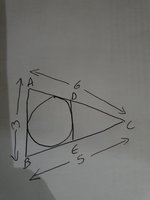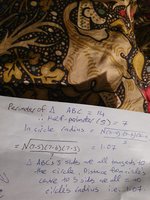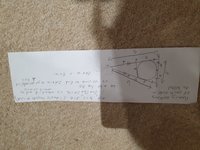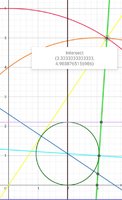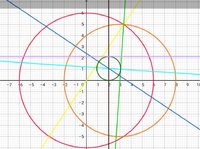You are using an out of date browser. It may not display this or other websites correctly.
You should upgrade or use an alternative browser.
You should upgrade or use an alternative browser.
Find perimeter of internal triangle
- Thread starter Marchburn
- Start date
Dr.Peterson
Elite Member
- Joined
- Nov 12, 2017
- Messages
- 16,871
It's interesting that we are told nothing about D and E, such as that DE||AB. This suggests it must not matter. Keep that in mind.The lines touching the circle are tangent.
The question is: what is the perimeter of the triangle CDE..?
I might start labeling all segments in the figure with variables indicating which are equal. That would include the points of tangency, and the radii they imply.
Dr.Peterson
Elite Member
- Joined
- Nov 12, 2017
- Messages
- 16,871
No, neither the angles nor the value of the inradius will help.Was also considering whether it was useful to work out anglea of triangle ABC using cosine law but don't think that would get me anywhere.
As I said, just name each segment of each side; for example, you might name the two parts of the left-hand side as a and b, then continue around. Look for congruent segments, related to tangents, and then write a couple equations.
Dr.Peterson
Elite Member
- Joined
- Nov 12, 2017
- Messages
- 16,871

You've missed three of the four points of tangency. Mark and label those points before you do anything else.
Each of the long sides ought to be divided into 3 parts, not just 2. And when you say a=f, f has to stop at a point of tangency, not go to D. (In my work, I just labeled both of the two equal parts a, but it's okay to state that equality separately.) Similarly, if d is only CE, and doesn't extend to the point of tangency, then it is not true that d=e.
But you're doing the right kind of things.
pka
Elite Member
- Joined
- Jan 29, 2005
- Messages
- 11,978
I wish that you had up-front said that the circle was tangent to each side of \(\Delta ABC\).
Suppose that \(x\) is the length of the tangent from \(A\) to the circle;
suppose that \(y\) is the length of the tangent from \(B\) to the circle; and
suppose that \(z\) is the length of the tangent from \(C\) to the circle.
That gives us:\(\\x+y=3\\y+z=5\\z+x=6.\) Can you finish?
Suppose that \(x\) is the length of the tangent from \(A\) to the circle;
suppose that \(y\) is the length of the tangent from \(B\) to the circle; and
suppose that \(z\) is the length of the tangent from \(C\) to the circle.
That gives us:\(\\x+y=3\\y+z=5\\z+x=6.\) Can you finish?
Th
Thanks for your help. Got the perimeter to be 8.View attachment 23559
You've missed three of the four points of tangency. Mark and label those points before you do anything else.
Each of the long sides ought to be divided into 3 parts, not just 2. And when you say a=f, f has to stop at a point of tangency, not go to D. (In my work, I just labeled both of the two equal parts a, but it's okay to state that equality separately.) Similarly, if d is only CE, and doesn't extend to the point of tangency, then it is not true that d=e.
But you're doing the right kind of things.

